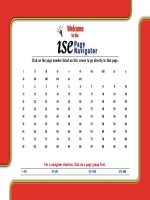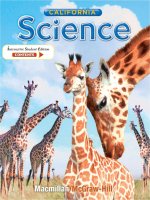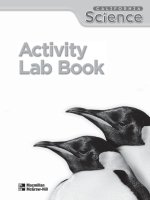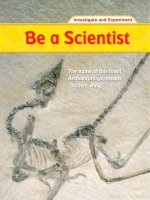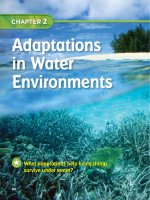- Trang chủ >>
- THPT Quốc Gia >>
- Hóa
California science grade 5 (6)
Bạn đang xem bản rút gọn của tài liệu. Xem và tải ngay bản đầy đủ của tài liệu tại đây (8.96 MB, 47 trang )
Chapter 1
Chapter 2
Chapter 3
Re
oo
dw
ds
a re
t he
tal
le s
t tr
ee
s in
t he
rl
wo
d.
P5_CAUA_UO_284379.indd 19
1/4/06 4:58:25 PM
CHAPTER 1
Structure
of Living
Things
What are living things made of?
P5_CAUAC1_CO_284379.indd 20
1/4/06 5:01:08 PM
Lesson
1
Cells
PAGE
24
Lesson
2
From Cells
to Organisms
PAGE
36
Lesson
3
Diversity
of Organisms
PAGE
46
5 LS 2. Plants and animals have structures
for respiration, digestion, waste disposal,
and transport of materials.
P5_CAUAC1_CO_284379.indd 21
1/4/06 5:01:22 PM
Literature
MAGAZINE ARTICLE
ELA R 5.2.3.
Discern main
ideas and
concepts presented in
texts, identifying and
assessing evidence that
supports those ideas.
ELA W 5.2.4. Write
persuasive letters
or compositions: b.
Support a position
with relevant
evidence.
22
P5_CAUAC01_LIT_284379.F.indd 22
1/10/06 1:48:26 PM
from SCHOLASTIC SUPERSCIENCE
People already use the super-sniffing nose
power of dogs for many important jobs, like
finding people trapped in avalanches. Now
scientists have discovered that man’s best
friend can also use its nose to detect cancer.
Cancer is a disease in which cells (the body’s
most basic unit of life) multiply without
stopping. For a long time scientists suspected
that these cells give off a unique smell. To
find out for sure, they put six dogs to the test.
The dogs were trained to sniff samples and lie
down next to the one that came from a patient
suffering from cancer. The dogs picked the
correct sample almost half the time.
Scientists hope to use this information
to create tests that will check a cell’s
odor to determine whether a
person has cancer. Who says
you can’t teach an old dog new
life-saving tricks?
▲ This dog was trained
to find the sample
with cancer cells.
Write About It
Response to Literature
In this article you learned
that dogs are being used to
detect cancer. Write a letter to
the editor of your local newspaper.
State your position about using
dogs for research. Include convincing
evidence that backs up your position.
▲ A cancer cell. Cancer cells
divide much more rapidly
than normal cells.
-Journal Write about it online @ www.macmillanmh.com
23
P5_CAUAC01_LIT_284379.F.indd 23
1/8/06 4:46:36 PM
Lesson 1
Cells
All living things are made of very similar tiny
structures. The ones you see here are part of
a plant. What is it about these structures that
allows us to be alive?
Building block lesson for 5 LS 2.a. Students know many multicellular organisms have
specialized structures to support the transport of materials.
P5_CAUAC01_L1_284379.F.indd 24
12/22/05 11:18:39 AM
What are plants
and animals made of?
Materials
Make a Prediction
Animals and plants are living things. Think about
the differences between plants and animals. Do
you think these differences mean that the parts
that they are made of are similar or different?
Test Your Prediction
• microscope
• prepared slides of
leaf cells
Observe Look at the prepared slide of a
leaf under the microscope. For help using the
microscope, ask your teacher and look at
page 461.
• prepared slides of
blood cells
Record Data Draw what you see.
Step
Observe Look at the prepared slide of blood
under the microscope.
Record Data Draw what you see.
Draw Conclusions
Compare How were the plant leaf slide
and animal blood slide alike? How were
they different?
Step
Communicate Write a report explaining
whether or not your observations supported
your prediction.
Explore More
Examine the drawings you made and think about
the living things they came from. Do you think that a
leaf from another plant would look the same? Make a
prediction and plan an experiment to test it.
Step
5 IE 6.i. Write a report of an investigation that
includes conducting tests, collecting data or
examining evidence, and drawing conclusions.
P5_CAUAC01_L1_284379.F.indd 25
12/22/05 11:18:50 AM
What are plants and animals
made of?
▶
Plants and animals are
made of cells. Cells are
the smallest units that can
carry out life processes.
▶ Vocabulary
cell , p. 26
organelle , p. 27
cell membrane , p. 29
cytoplasm , p. 29
nucleus , p. 29
mitochondria , p. 29
vacuole , p. 29
cell wall , p. 31
chloroplast , p. 31
microscope , p. 32
Plants, animals, and all living things are made
of cells. A cell (SEL) is the smallest unit of a
living thing that can carry out the basic processes
of life. Grass and mountain lions are made of
cells. Your own body is made up of trillions of
these tiny building blocks.
▼ This mountain lion and the
grass are made of many cells.
-Glossary
@
www.macmillanmh.com
▶ Reading Skill
Summarize
Ac[[O`g
26
EXPLAIN
P5_CAUAC01_L1_284379.F.indd 26
12/22/05 11:18:56 AM
The cells of different living things
are similar in many ways. All cells need
energy to carry out life processes. All
cells have structures, called organelles
(awr•guh•NELZ) that work together to
help them perform life processes. These
organelles have jobs that must be done
to keep the cell alive.
▲ plant cells
The cells of living things also have
some important differences. For
example, many plants need to grow tall
to reach the sunlight. This means they
need something in their cells to provide
extra support. Plants can’t move to find
water when it doesn’t rain. So plant
cells need to be able to store a lot of
water. Plants usually don’t eat other
living things, so their cells need special
organelles to produce their own food.
Unlike plants, animals move around
from place to place. They need cells
that are more flexible and allow more
movement. Since animals can move
to find water, their cells do not need
to store as much water as plant cells.
Animals do not have cells that produce
their food. They must get their energy
from eating other living things.
Quick Check
Summarize Describe the
▲ animal cells
relationship between a cell and a
living thing.
Critical Thinking What is the
difference between a living thing
and a nonliving thing?
27
EXPLAIN
P5_CAUAC01_L1_284379.F.indd 27
12/22/05 11:19:01 AM
What are the organelles in animal cells?
If you look at cells through a microscope, you can see that
cells have several organelles in them. These organelles work
together to keep the cell alive. Look at the diagram of the
animal cell to learn about its different parts.
Animal Cell
nucleus
cytoplasm
mitochondrion
vacuole
cell membrane
28
EXPLAIN
P5_CAUAC01_L1_284379.F.indd 28
12/22/05 11:19:04 AM
Cell Membrane
All animal cells have a cell membrane
(MEM•brayn) . The cell membrane is a
layer around the outside of the cell. It
gives the cell shape and controls what
moves in and out of the cell.
The cell membrane only allows
certain materials to enter and exit the
cell. It is very selective. It wraps around
the outside of the cell in somewhat the
same way your skin wraps around you.
Cytoplasm
Inside the cell membrane is the
cytoplasm (SIGH•tuh•PLAZ•uhm).
The cytoplasm is a gel-like substance
that supports all of the organelles
that carry out the different jobs in the
cell. Cytoplasm is constantly moving
through the cell in a stream-like motion.
Nucleus
The nucleus (NEW•klee•uhs) is
a large spherical structure found in
the center of the cell. It has a double
membrane with pores, or openings,
to allow certain materials to pass in
and out.
The nucleus controls all of the
activity in the cell. It sends signals to
the other parts of the cell. The nucleus
tells the cell when it is time to break
down food, to grow, to move, and even
when it’s time for the cell to die.
Mitochondria
Cells have many oval sacs called
Mitochondria (migh•tuh•KON•dree•uh).
sacs have a folded inner
membrane. The folds give the
mitochondria more surface area.
The increased surface area allow
the mitochondria to do more work
for the cell. A mitochondrion
(migh•tuh•KON•dree•uhn), a single
mitochondria, breaks down food and
turns it into energy for the cell to use.
The more energy a cell needs, the more
mitochondria that cell will have. Very
active cells, such as human liver cells,
need a lot of mitochondria.
These
Vacuoles
Cells also contain organelles called
vacuoles (VAK•yew•ohls) that store
water, food, and wastes. The nucleus
can signal a vacuole to release whatever
it is holding. Animal cells may have
many small vacuoles and some may not
have any vacuoles.
Quick Check
Summarize Describe the parts of
animal cells.
Critical Thinking Do you think
a cell would function without a
nucleus? Explain.
29
EXPLAIN
P5_CAUAC01_L1_284379.F.indd 29
12/22/05 11:19:11 AM
What are the organelles in plant cells?
Plant cells have the same organelles as animal cells. They
also have some structures that animal cells do not have. Look
at the diagram of the plant cell to learn about its parts.
Plant Cell
nucleus
vacuole
mitochondrion
cytoplasm
chloroplast
cell wall
cell membrane
Reading Diagrams
Which structures in plant and animal cells are the same?
Draw a Venn diagram to answer the question.
Clue: Look at the labels in this plant cell diagram and the animal cell diagram on page 28.
30
EXPLAIN
P5_CAUAC01_L1_284379.F.indd 30
12/22/05 11:19:12 AM
Plant cells have an additional layer
around the outside of the cell. This
layer is called the cell wall. Cell walls
are made from a hard, specialized sugar
called cellulose. Cellulose protects plant
cells and gives them their shape.
The cell wall lets food and wastes
move in and out of the cell, but its main
job is to provide extra support. Cell
walls are part of the reason why trees
can grow as tall as they do.
Vacuole
Unlike animal cells, plant cells have
one large central vacuole that stores
water and also provides support. Have
you seen what happens to a plant
when it doesn’t get enough water? The
vacuoles release the water they were
storing into the cells. This causes the
vacuoles to shrink, which makes the
cells become smaller. This makes the
plant wilt, or bend over. Once you
water the plant, the vacuoles have water
again and the plant stands back up.
Chloroplasts
What makes plants green? Many
plant cells contain structures called
chloroplasts (KLAWR•uh•plasts) that
turn energy from sunlight into food.
Chloroplasts are green because they
contain a green chemical called
chlorophyll (KLAWR•uh•fil). Some
plants have chemicals that make other
colors. However, there is usually so
much more chlorophyll that you don’t
Plant and Animal Cells
Make a Model
Put one plastic
bag in the storage
container. This is
your plant cell.
The other plastic
bag is your
animal cell.
Using a spoon, carefully put
gelatin in both bags until the bags
are almost full.
Pick vegetables that look the
most like the plant and animal
organelles.
Place the vegetables that you
have picked into the appropriate
container and seal the bags.
Compare Try to stack your
models. How well do the plant
cells stack compared to the
animal cells?
Communicate Discuss with your
classmates which vegetables you
selected for your organelles and
explain why.
see the other colors. In the fall, as the
leaves die, the chlorophyll break down.
Then you can see leaves change from
green to other colors.
Quick Check
Summarize What do vacuoles do in
plant cells?
Critical Thinking Do you think
desert plants have vacuoles?
31
EXPLAIN
P5_CAUAC01_L1_284379.F.indd 31
12/22/05 11:19:24 AM
How can cells be seen?
For thousands of years people didn’t realize that living things as
tiny as cells existed. This is because cells are so small they cannot
be seen with our eyes only. A microscope (MIGH•kruh•skohp) is an
instrument that magnifies objects, or makes them look bigger. It took
almost 200 years after the first cells were seen under a microscope
before scientists realized that all living things are made of cells.
Microscope Timeline
1595—Zacharias
Janssen creates
the first compound
microscope.
1670s—Dutch
scientist Anton van
Leeuwenhoek improves
lens technology to
magnify between 75
and 200 times.
1940s—Electron
microscopes
magnify 40,000
times more
than previous
microscopes.
1860s–1890s—
Scientists develop
new ways of
staining cells so
they are easier to
see and study under
a microscope.
1665—English scientist
Robert Hooke studies slices
of cork, calling the tiny
boxes that he sees “cells”
after a Latin word that
means “little rooms.”
1982—Scientists build
the scanning tunneling
microscope that allows you
to see individual blood cells.
Reading Diagrams
Quick Check
In what year did Robert Hooke
first see cork cells?
Summarize What prevented people
Clue: Look at the diagram for
the picture of cork cells. Read the
caption and look for the year.
from realizing that cells and other tiny
living things existed?
Critical Thinking What are some
reasons that it is important for scientists
to be able to see cells clearly?
32
EXPLAIN
P5_CAUAC01_L1_284379.F.indd 32
12/22/05 11:19:26 AM
Summarize the Main Idea
All living things are
made of cells, which
are the smallest unit
of a living thing that
can carry out the basic
processes of life.
(pp. 26–27)
Animal cells and plant
cells have structures
that work together
to keep the cell alive.
Plant cells have some
different structures than
animal cells. (pp. 28–31)
Think, Talk, and Write
Main Idea What are cells?
Vocabulary A structure that stores
food, water, and wastes in plant and
animal cells is a
.
Summarize What do mitochondria do
in both plant and animal cells?
Ac[[O`g
Critical Thinking Explain why animal
cells do not have chloroplasts.
Microscopes magnify
tiny objects and can
be used to study cells.
(p. 32)
Make a
Study Guide
Test Practice Which organelle
controls the activity of the cell?
A mitochondrion
B chloroplast
C nucleus
D vacuole
Test Practice Which bestt describes
Make a half-book
(see p. 479). Use the
titles shown. On the
inside of the fold,
summarize what you
have learned about
cells, cell structures
and microscopes.
Writing Link
the cell membrane?
A controls what moves in and out
B stores water, food, and wastes
C turns food into energy
D produces food for the cell
Math Link
Expository Writing
How small are cells?
Select an organelle and research what
it does in the cell. Explain its function
in the cell.
Animal cells can be as small as 1/1000
of a millimeter. Write this number as a
decimal and as a percent.
-Review Summaries and quizzes online @ www.macmillanmh.com
33
EVALUATE
P5_CAUAC01_L1_284379.F.indd 33
12/22/05 11:19:28 AM
Experiment
experiment
Learn It
experiment
experiment
experiment
Try It
▶
▶
▶
▶
5 IE 6.f. Select appropriate tools (e.g., thermometers, meter sticks, balances, and
graduated cylinders) and make quantitative observations. • 5 IE 6.c. Plan and conduct
a simple investigation based on a student-developed question and write instructions
others can follow to carry out the procedure.
P5_CAUAC01_L1_ISB_284379.F.indd 34
1/3/06 3:41:55 PM
▶
▶
Apply It
▶
▶
P5_CAUAC01_L1_ISB_284379.F.indd 35
1/3/06 3:42:11 PM
Lesson 2
From Cells
to Organisms
You could say that the levels of organization of a school
are bricks, walls, rooms, and finally the school building.
Living things also have levels of organization. How are
organisms, like an onion plant, organized?
Building block lesson for 5 LS 2.a. Students know many
multicellular organisms have specialized structures to
support the transport of materials.
P5_CAUAC01_L2_284379_F.indd 36
1/4/06 4:55:33 PM
What are the levels of
organization of living things?
Materials
Purpose
To research the levels of organization of an
onion plant.
Procedure
Peel the skin of an onion.
Make a wet-mount slide by placing a small
piece of the onion skin in the center of the
slide, then put a drop of water on the onion
skin. Carefully put a cover slip on top.
• onion
Observe View the onion skin under low
• slides
power. What do the cells looks like? Draw what
you see.
• water
• gloves
• goggles
• microscope
Observe Use the hand lens to observe
• hand lens
another piece of onion skin. Draw what
you see.
Step
Take the remaining onion and remove all of
its parts. Make a diagram of the structure of
the onion.
Draw Conclusions
Compare Are the various onion cells you
observed in the onion layer similar or different?
Infer How do these cells work together?
Explore More
Step
Research the levels of organization of the onion
plant. Answer these questions with a labeled
diagram. What is an onion? Is it part of the root
or the stem?
5 IE 6.g. Record data by using appropriate graphic
representations (including charts, graphs, and labeled
diagrams) and make inferences based on those data.
P5_CAUAC01_L2_284379_F.indd 37
1/4/06 4:55:45 PM
How are living things
organized?
▶ Main Idea
Cells make up tissues,
which make up organs,
which make up organ
systems.
▶ Vocabulary
unicellular , p. 38
organism , p. 38
multicellular , p. 39
tissue , p. 40
organ , p. 40
organ system , p. 41
-Glossary
@
www.macmillanmh.com
As you have learned, cells are the
smallest units of living things that can
carry out the basic processes of life.
Unicellular (YEW•nuh•SEL•yuh•luhr),
or one-celled, organisms
(AWR•guh•niz•uhm) can carry out all
of the processes of life within a single
cell. An organism is an individual
living thing. Diatoms are examples of
unicellular organisms. Diatoms live in
fresh water and salt water. They float
on the water’s surface and are eaten by
many other organisms. They have glasslike cell walls.
▶ Reading Skill
Compare and Contrast
2WTTS`S\b
/ZWYS
▼ Diatoms are unicellular living things
found in fresh water and salt water.
2WTTS`S\b
Explore the levels of
organization from
cells to organs with
Team Earth.
38
EXPLAIN
P5_CAUAC01_L2_284379_F.indd 38
1/4/06 4:55:52 PM
Organisms that are made
of many different kinds of cells are
multicellular (mul•tee•SEL•yuh•luhr).
Animals and plants are examples
of multicellular organisms.
▼ This mountain lion cub is
a multicellular organism.
In multicellular organisms,
every cell carries out its own life
processes. The cells also work
together to take care of different
functions for the organism. For
example, all of your heart muscle
cells carry out their own life
processes and they work together
to keep your heart beating.
Life Processes in Living Things
Growth
Response
Reproduction
Nutrition
Respiration
Excretion
The ability to increase in size
The ability to react to changes in surroundings
The ability to produce offspring
The ability to take in food or raw materials to support other life processes
The ability to break down food into energy
The removal of waste
Reading Charts
Quick Check
Compare and Contrast What activities
are common to all living things?
What is respiration?
Clue: Look at the rows in the
chart. Find the row that gives
information about respiration.
Critical Thinking Are multicellular
organisms made of unicellular
organisms? Explain your answer.
39
EXPLAIN
P5_CAUAC01_L2_284379_F.indd 39
11/2/06 4:44:52 PM
How do cells work together?
A group of similar cells that do the same job in an organism
is a called a tissue (TISH•ew). Both plants and animals have
tissues. Muscle cells in your legs make up muscle tissue, which
allows you to move your legs. Other kinds of tissues in an
animal’s body include blood, nerves, bone, and skin.
One kind of plant tissue carries water and minerals from
a plant’s roots through the stems to the leaves. Another
example of a plant tissue is the flesh of fruits. The function of
this tissue is to protect the plant’s seeds.
In plants and animals, tissues of different kinds come
together to make up an organ (AWR•guhn). Stems and fruits
From Cells to Organisms
cell
tissue
organ
organ system
Reading Diagrams
Give an example of an animal organ and a plant organ.
Clue: Use the labels in the diagram to find the answer.
to form organisms @
www.macmillanmh.com
40
EXPLAIN
P5_CAUAC01_L2_284379_F.indd 40
1/4/06 4:55:59 PM
are examples of a plant’s organs.
The onion is an example of an organ
that stores food. The brain, lungs,
heart, and stomach are examples
of animal organs.
Muscle Tissues
A group of organs that work
together to do a certain job is an
organ system. Organ systems, like
the different transport systems in
animals and plants, help carry out
an organism’s life processes.
Make a Model Tie a piece of yarn
between two chairs. Have two
classmates sit on each chair. This
yarn represents one cell in your
muscle tissue.
Using a metal ruler, twist the yarn
until it snaps.
Now tie two pieces of yarn to the
chairs. Try to break the yarn again.
organism
Repeat this experiment until you
have enough pieces of yarn that
the twisting cannot break it.
How does this model show how
muscle cells work in your body?
Infer Are your muscles stronger
when cells work together?
Quick Check
Compare and Contrast How do
organs compare to organ systems?
Critical Thinking Do you think
cells from different organs, like the
heart and lungs, can be switched?
Explain.
41
EXPLAIN
P5_CAUAC01_L2_284379_F.indd 41
1/4/06 4:56:03 PM
Animal System
Plant System
skeletal
system
root
system
▲ The skeletal system is a
support system in animals.
▲ The root system is a
transport system in plants.
What are some plant and
animal organ systems?
and brain are part of systems that
control the salamander’s movements
and responses. The salamander has an
organ system for respiration. Its skin
and lungs are organs in this system.
The skin is also part of the organ
system that protects the salamander.
The salamander’s heart is part of the
organ system that transports its blood
and other materials.
Multicellular organisms, like a
dandelion plant or a salamander, have
several organ systems. Plants and
animals use different organ systems to
carry out their life processes.
The roots of a dandelion, and other
plants, are the main organ in the root
system. Stems and leaves are organs of
the shoot system. Plants also have other
systems for transporting materials and
for reproduction.
The salamander, like other animals,
has an organ system that breaks down
food for energy. The stomach is part
of this system. The bones, muscles,
Quick Check
Compare and Contrast Which
organ systems of plants and animals
carry out similar functions?
Critical Thinking Can an organ be
part of two organ systems?
42
EXPLAIN
P5_CAUAC01_L2_284379_F.indd 42
1/7/06 11:38:06 AM
Summarize the Main Idea
A unicellular organism
carries out life processes
within one cell. A
multicellular organism
has specialized cells to
carry out life processes.
(pp. 38–39)
A tissue is a group of
cells that work at the
same job. Tissues form
organs, which work
together and form
organ systems. Organ
systems make up the
organism. (pp. 40–41)
Plants and animals
have many different
organ systems to carry
out life processes.
(p. 42)
Make a
Study Guide
Think, Talk, and Write
Main Idea What are multicellular
organisms made up of?
Vocabulary A group of similar cells
that work together is a(n)
.
Compare and Contrast Compare the
organization in plants and animals.
2WTTS`S\b
/ZWYS
2WTTS`S\b
Critical Thinking Could an organism
survive without one of its organs?
Test Practice Which of the following
life processes removes wastes?
A response
B reproduction
C excretion
D nutrition
Test Practice Which of the following
Make a half-book (see
p. 479). Use the titles
shown. On the inside
of the fold, compare
and contrast each of
the topics.
Writing Link
Explanatory Writing
Research one of your organs, such as
your heart. Write about the functions
of this organ and its organ system.
is
A
B
C
D
a unicellular organism?
a human
a plant
a diatom
an animal
Math Link
Your skin is the largest organ in your
body. You lose about 30,000 dead skin
cells every minute. How many skin cells
does your body lose in a day?
-Review Summaries and quizzes online @ www.macmillanmh.com
43
EVALUATE
P5_CAUAC01_L2_284379_F.indd 43
1/7/06 11:38:08 AM

